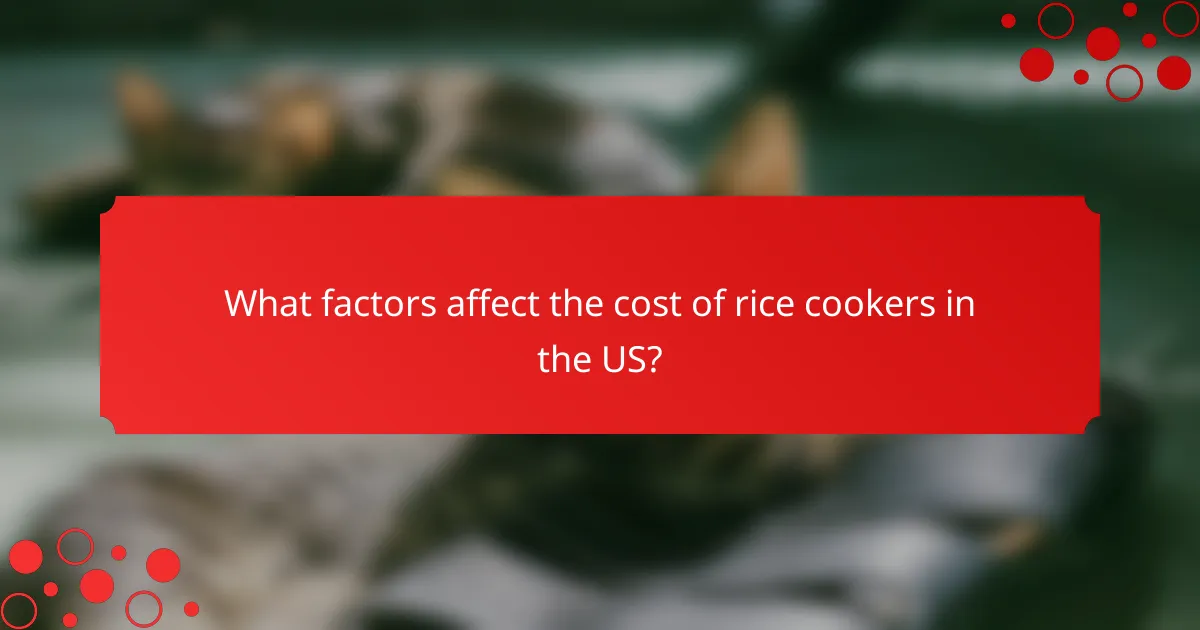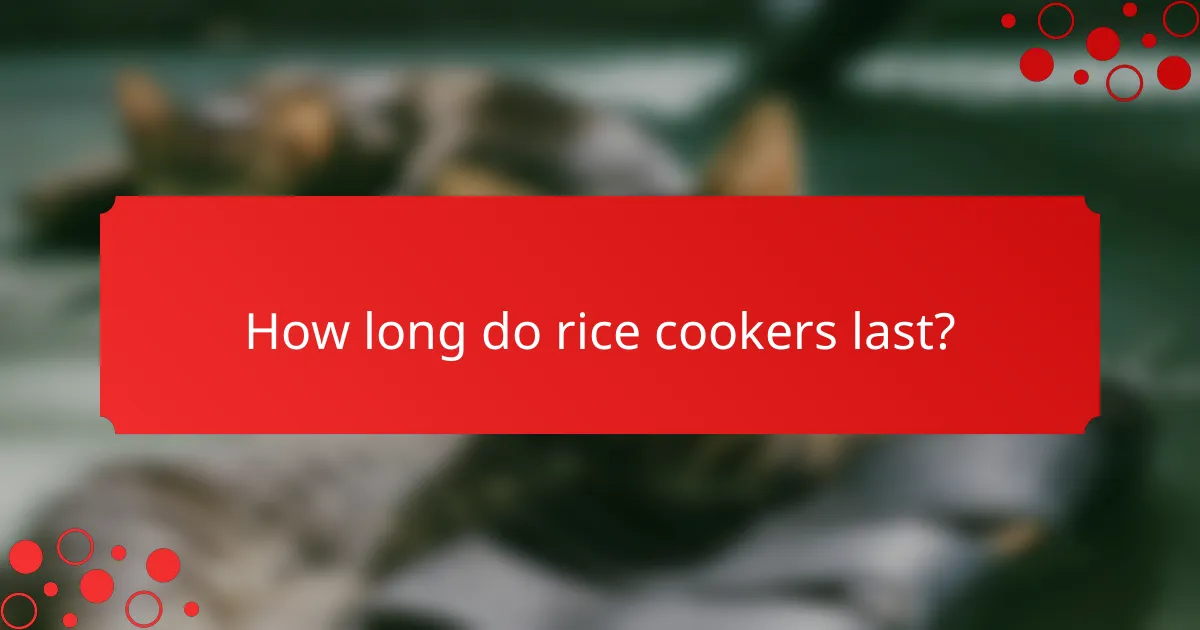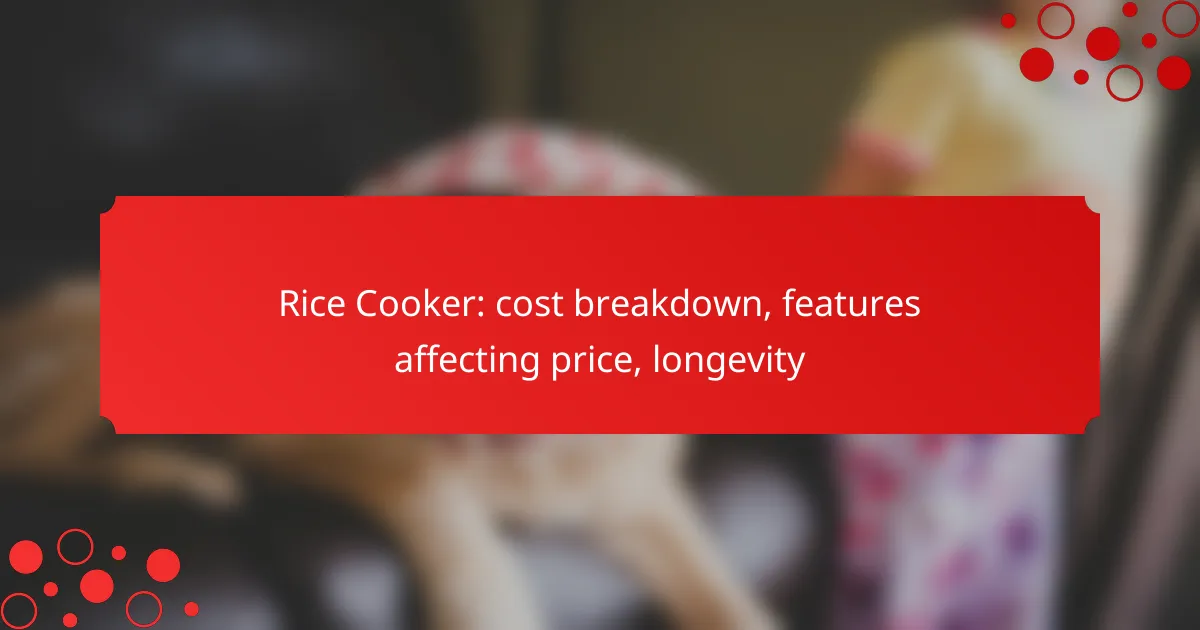When considering a rice cooker, it’s essential to understand the various factors that influence its cost, such as brand reputation, cooking capacity, and advanced features. Prices typically range from under $50 for basic models to over $150 for high-end options, with the price often reflecting the technology and materials used. By evaluating these elements, you can make a well-informed decision that aligns with your cooking needs and budget.

What factors affect the cost of rice cookers in the US?
The cost of rice cookers in the US is influenced by several key factors, including brand reputation, cooking capacity, advanced features, material quality, and warranty options. Understanding these elements can help you make an informed purchasing decision based on your needs and budget.
Brand reputation
Brand reputation plays a significant role in the pricing of rice cookers. Established brands often command higher prices due to their proven reliability and customer satisfaction. Newer or lesser-known brands may offer more affordable options but could lack the same level of quality assurance.
When considering a brand, look for reviews and ratings from other consumers. Brands with a strong track record in kitchen appliances typically provide better performance and durability, which can justify a higher initial investment.
Cooking capacity
The cooking capacity of rice cookers varies widely, typically ranging from 3 to 10 cups of uncooked rice. Smaller models are generally less expensive, making them suitable for individuals or small families, while larger models can accommodate bigger households or meal prep needs.
When selecting a capacity, consider your typical serving sizes and how often you cook rice. A larger capacity may be more cost-effective in the long run if you frequently prepare rice for multiple people.
Advanced features
Advanced features such as fuzzy logic, multiple cooking settings, and programmable timers can significantly increase the price of rice cookers. Fuzzy logic technology allows the cooker to adjust cooking times and temperatures automatically, resulting in better rice quality.
While these features enhance convenience and cooking precision, they may not be necessary for everyone. If you primarily cook plain rice, a basic model may suffice, saving you money without sacrificing quality.
Material quality
The materials used in rice cookers affect both their durability and price. Cookers made with high-quality stainless steel or non-stick inner pots tend to be more expensive but offer better heat distribution and easier cleaning.
When evaluating material quality, consider how often you plan to use the cooker. Investing in a well-made model can lead to longer-lasting performance, while cheaper materials may wear out more quickly, leading to additional costs over time.
Warranty and support
A strong warranty and customer support can influence the overall cost of a rice cooker. Models with longer warranties often reflect higher quality and manufacturer confidence, typically ranging from one to several years.
Before purchasing, check the warranty terms and what they cover. Good customer support can also be invaluable for troubleshooting and maintenance, making it worth considering when evaluating price versus value.

How much do rice cookers typically cost?
Rice cookers generally range from budget-friendly options under $50 to high-end models exceeding $150. The price often reflects the features, capacity, and technology used in the cooker.
Budget models under $50
Budget rice cookers typically cost less than $50 and are suitable for basic cooking needs. These models often have a simple design with limited features, such as a basic on/off switch and a non-stick inner pot.
While they may lack advanced functionalities, budget models can still cook rice effectively. However, they may not have the same durability or consistency as more expensive options.
Mid-range models $50-$150
Mid-range rice cookers, priced between $50 and $150, offer a balance of features and performance. These models often include programmable settings, multiple cooking functions, and better build quality.
Many mid-range options come with features like keep-warm functions and steaming trays, making them versatile for various dishes. They are generally more reliable and durable than budget models, making them a good investment for regular users.
High-end models over $150
High-end rice cookers, costing over $150, are designed for serious cooks and often include advanced technology. Features may include fuzzy logic, induction heating, and precise temperature control, allowing for perfect rice every time.
These models can handle a variety of grains and cooking methods, often with multiple settings for different types of rice. While they require a higher upfront investment, their longevity and performance can justify the cost for frequent users.

What are the key features of rice cookers that influence price?
The price of rice cookers is significantly influenced by their features, which can range from basic cooking functions to advanced technology. Key factors include multi-function capabilities, smart technology integration, the quality of the inner pot, and the inclusion of additional accessories like steam baskets.
Multi-function capabilities
Rice cookers with multi-function capabilities can perform various cooking tasks beyond just making rice, such as steaming vegetables, slow cooking, or even baking. These versatile appliances often come with preset cooking programs, which can justify a higher price point. For example, a basic rice cooker may cost around $20, while a multi-functional model can range from $50 to over $200.
When considering a multi-function rice cooker, evaluate how often you will use these additional features. If you primarily cook rice, a simpler model may suffice, while a more versatile cooker is beneficial for diverse meal preparation.
Smart technology integration
Smart technology in rice cookers allows for remote operation and monitoring through smartphone apps, voice commands, or integration with smart home systems. This feature can significantly increase the price, with smart models typically starting around $100 and going up to $300 or more. Users can enjoy convenience and precision cooking, adjusting settings from anywhere.
However, consider whether you truly need smart features. If you prefer straightforward cooking without the need for connectivity, a traditional model may be more cost-effective.
Non-stick inner pot
A non-stick inner pot is a desirable feature that makes cooking and cleaning easier, preventing rice from sticking and burning. Cookers with high-quality non-stick coatings tend to be more expensive, often ranging from $30 to $150. This investment can save time and effort in maintenance.
When selecting a rice cooker, check the durability of the non-stick coating. Some cheaper models may wear out quickly, leading to food sticking and requiring replacement sooner than expected.
Steam basket inclusion
A steam basket is a valuable accessory that allows for healthy cooking by steaming vegetables or fish while rice cooks simultaneously. Cookers that include a steam basket typically have a higher price, often adding $10 to $30 to the overall cost. This feature enhances meal versatility and can promote healthier eating habits.
If you frequently steam food, look for models that come with a steam basket. If not, you may find it more economical to purchase a separate steamer or stick with a basic rice cooker.

How long do rice cookers last?
Rice cookers typically last between 5 to 10 years, depending on the brand, model, and usage. Regular maintenance and proper handling can extend their lifespan significantly.
Average lifespan of rice cookers
The average lifespan of rice cookers varies widely, with budget models lasting around 3 to 5 years, while higher-end versions can last up to 10 years or more. Users often report that well-maintained cookers can exceed these averages, especially if they are used sparingly.
In general, the longevity of a rice cooker is influenced by its build quality and the frequency of use. A rice cooker used daily may wear out faster than one used occasionally.
Factors affecting longevity
Several factors impact the longevity of rice cookers, including the quality of materials, frequency of use, and cooking habits. Cookers made from durable materials like stainless steel tend to last longer than those made from plastic.
Additionally, features such as programmable settings and advanced technology can affect durability. More complex models may have more components that can fail over time, while simpler designs may be more robust.
Maintenance tips for durability
To ensure a long lifespan for your rice cooker, follow these maintenance tips. Always clean the inner pot and lid after each use to prevent residue buildup, which can affect performance.
Avoid using metal utensils inside the cooker to prevent scratching the non-stick surface. Regularly check the power cord and plug for any signs of wear, and store the cooker in a dry place to prevent moisture damage.



